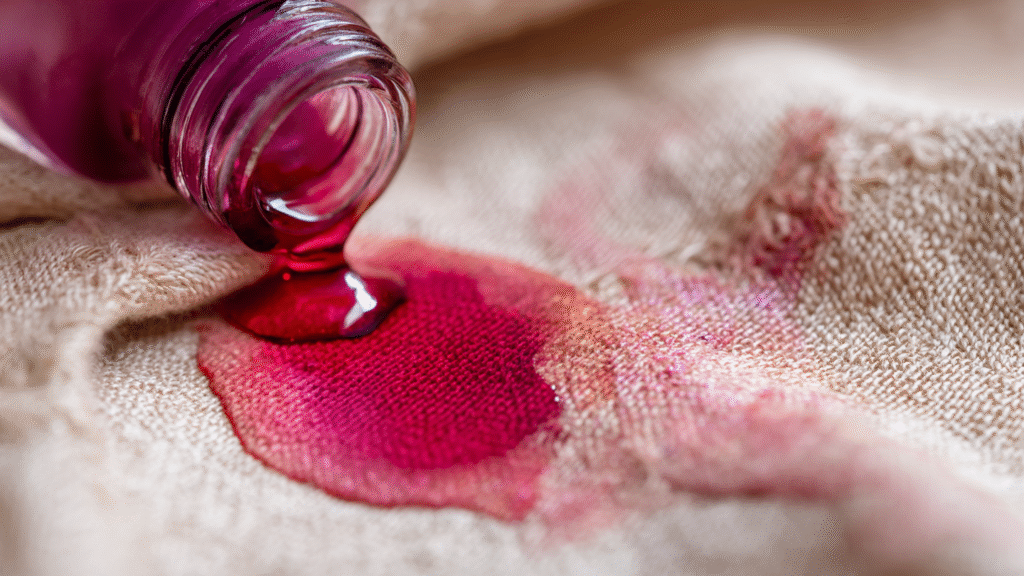Nail polish isn’t like regular makeup or food stains. It’s made with resins, pigments, and solvents designed to adhere strongly to nails — which unfortunately also makes it bind tightly to fabric. Once it dries, it hardens, creating a tough film that resists water and standard laundry detergents.
Some fabrics, like acetate, silk, and wool, react badly to solvents like acetone, making the cleaning process even trickier. That’s why experts at Martha Stewart stress the importance of identifying fabric type before applying any stain remover.
How to Get Fresh Nail Polish Out of Clothes
If the polish is still wet or only partially dried, your chances of full removal are much higher. Use the following method:
- Start by placing layers of absorbent paper towels or a clean white cloth beneath the stained area (on the reverse side).
- Use a cotton swab or pad soaked in nail polish remover (acetone-based or non-acetone, depending on fabric) and dab gently from the outside inward, gradually lifting the stain.
- Replace your swabs or cloths as they pick up pigment so you don’t re-deposit it.
- Once most of it is lifted, rinse the treated area under cold water to flush out residual solvent.
- Treat any remaining faint color with rubbing alcohol or a gentle detergent solution, then wash normally.
- Don’t put the garment in a hot dryer until you’re sure the stain is gone.
This method is endorsed by cleaners and style authorities like Martha Stewart (in her guide on how to remove nail polish from clothes) who emphasize careful dabbing and color tests.Martha Stewart
Also, Tide recommends a similar six-step process using detergent and acetone (with precautions) to tackle polish stains.tide.com
How to Remove Dried Nail Polish Stains
Stains that have already dried are tougher but not hopeless. Here’s a safe, stepwise approach:
- First, gently scrape or chip off any hardened edges using a dull tool. Be gentle to avoid damaging the fabric.
- Apply a small amount of nail polish remover or acetone-based solvent (if safe for the fabric) using a cotton swab.
- Work from the edges toward the center, blotting as you go, and continually moving to clean swabs or towels.
- Rinse under cold water and check if more color persists.
- If traces remain, try rubbing alcohol (isopropyl) to lift residual pigment. Real Simple recommends precisely this technique.Real Simple
- Once the stain is mostly removed, launder as usual, and avoid heat until fully clean.
Martha Stewart also describes this method of repeating dab-and-rinse cycles to gradually remove dried stain traces.Martha Stewart
Using Household Products (Vinegar, Baking Soda, Hydrogen Peroxide)
If you don’t have commercial stain removers handy, these home remedies can help — though often more slowly and mildly:
- White Vinegar + Detergent
Mix equal parts white distilled vinegar and strong laundry detergent. Dab this mixture onto the stain, let it sit ~10 minutes, then blot with a damp cloth. - Baking Soda Paste
For lighter color stains: mix baking soda with water to make a paste. Apply to both sides of the fabric, let sit 15–30 minutes, then rinse.
Whirlpool recommends this for fabrics that can’t tolerate direct solvents.Whirlpool - Hydrogen Peroxide (for whites only)
Hydrogen peroxide can act as a mild bleaching agent, so use only on white fabrics or colorfast materials.
Better Homes & Gardens suggests its use for stains on white or light fabrics in some cases.Better Homes & Gardens - Dish Soap & Warm Water
Start by wetting the area, then gently work dish soap into the stain with a swab, rinse, and repeat. Whirlpool also suggests this gentle baseline.Whirlpool
These approaches are gentler but might require multiple applications and patience.
FAQs (Frequently Asked Questions)
How long do I have to act before a nail polish stain becomes permanent?
You ideally should start treatment within minutes. The longer polish sits, the more it bonds with fibers. But even dried stains can often be reduced or removed with repeated care.
Can I use hairspray or hand sanitizer on a nail polish stain?
Some people use alcohol-based hairspray or hand sanitizer (with high isopropyl content) to dissolve pigment. These can work on durable fabrics, but they may also damage dyes or fabrics — always test first. PB.nl describes using non-acetone remover or hairspray gently on stains.pb.nl
Will bleach remove nail polish stains?
Bleach (especially chlorine) is powerful and risky. It might remove color, but it can also damage or discolor fabrics. Only use on white, bleach-safe materials, and test carefully.
What if only the pigment (dye) remains after removing the resin?
Sometimes you may remove the polish film but still see a faint color stain (dye residue). Using rubbing alcohol, or a mild bleach (if safe for the fabric), may help remove the dye component.
Why shouldn’t I put the stained garment in the dryer?
Heat from a dryer causes any remaining stain molecules to set permanently into fabric fibers, making future removal extremely difficult or impossible.
Is it possible to rescue every garment stained with nail polish?
Not always. Some fabrics (especially acetate-based fibers) cannot tolerate solvents without damage. Deep, set stains may not fully come out. But many garments can be saved with patience and the right approach.
Conclusion
Spilling nail polish on your clothes can feel like a disaster — but with fast, careful action and the right methods, you often can recover your garments. The key is to blot, test, and treat wisely, using mild solvents or household remedies first, and reserving acetone or professional help for more stubborn cases.
